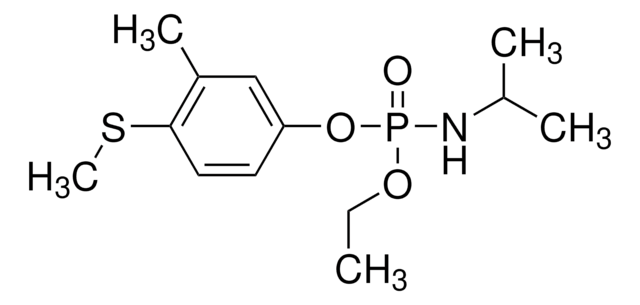Key Documents
51976
Ethyl alcohol, pure
≥99.8%, for molecular biology, (absolute alcohol, without additive, A15 o1), BioUltra
Synonim(y):
Ethyl alcohol
About This Item
Polecane produkty
product name
Ethanol, BioUltra, for molecular biology, ≥99.8%, (absolute alcohol, without additive, A15 o1)
klasa czystości
for molecular biology
Poziom jakości
gęstość pary
1.59 (vs air)
ciśnienie pary
44.6 mmHg ( 20 °C)
linia produktu
BioUltra
Próba
≥99.8%
Postać
liquid
temp. samozapłonu
683 °F
jakość
(absolute alcohol, without additive, A15 o1)
granice wybuchowości
19 %, 60 °F
zanieczyszczenia
DNases, none detected
KMnO4-reducing substances, in accordance
RNases, none detected
insoluble matter, passes filter test
phosphatases, none detected
proteases, none detected
substances darkened by H2SO4, in accordance
≤0.0004% free alkali (as NH3)
≤0.001% aldehyde (as CH3CHO)
≤0.001% formaldehyde (as HCHO)
≤0.001% ketone (as CH3COCH3)
≤0.002% free acid (as CH3COOH)
≤0.1% methanol (CH3OH)
≤0.2% water
pozostałość po odparowaniu
≤0.001%
współczynnik refrakcji
n20/D 1.3600 (lit.)
n20/D 1.362
tw
78 °C (lit.)
mp
−114 °C (lit.)
rozpuszczalność
H2O: miscible
organic solvents: miscible
ślady kationów
Al: ≤0.5 mg/kg
Ba: ≤0.1 mg/kg
Bi: ≤0.1 mg/kg
Ca: ≤0.5 mg/kg
Cd: ≤0.05 mg/kg
Co: ≤0.02 mg/kg
Cr: ≤0.02 mg/kg
Cu: ≤0.1 mg/kg
Fe: ≤0.1 mg/kg
K: ≤0.5 mg/kg
Li: ≤0.1 mg/kg
Mg: ≤0.1 mg/kg
Mn: ≤0.02 mg/kg
Mo: ≤0.1 mg/kg
Na: ≤1 mg/kg
Ni: ≤0.02 mg/kg
Pb: ≤0.1 mg/kg
Sr: ≤0.1 mg/kg
Zn: ≤0.1 mg/kg
ciąg SMILES
CCO
λ
neat
absorpcja UV
λ: 260 nm Amax: 0.04
λ: 280 nm Amax: 0.03
przydatność
suitable for molecular biology
Zastosowanie
life science and biopharma
format
neat
InChI
1S/C2H6O/c1-2-3/h3H,2H2,1H3
Klucz InChI
LFQSCWFLJHTTHZ-UHFFFAOYSA-N
Szukasz podobnych produktów? Odwiedź Przewodnik dotyczący porównywania produktów
Opis ogólny
Zastosowanie
- in vehicle-treated controls to perform mouse experiments
- in viability assay along with crystal violet to stain human and mouse high-grade serous ovarian cancer (HGSOC) cells after stimulation
- to prepare 17β-estradiol (E2) to use in cell culture experiments
- in cell cycle analysis for fixing cells drop-wise
Działania biochem./fizjol.
Cechy i korzyści
- Versatile and adaptable for a wide variety of laboratory and research applications
- BioUltra Grade for your Molecular Biology, Cell Biology and Biochemical research
- Tested to confirm low levels of heavy metal contamination, ensuring suitability for various applications
- Free from DNase, RNase, NICKase and proteaseTested for trace levels of Anions and Cations
Inne uwagi
Przypis
greener alternative product
najczęściej kupowane z tym produktem
produkt podobny
Hasło ostrzegawcze
Danger
Zwroty wskazujące rodzaj zagrożenia
Zwroty wskazujące środki ostrożności
Klasyfikacja zagrożeń
Eye Irrit. 2 - Flam. Liq. 2
Kod klasy składowania
3 - Flammable liquids
Klasa zagrożenia wodnego (WGK)
WGK 1
Temperatura zapłonu (°F)
55.4 °F - closed cup
Temperatura zapłonu (°C)
13 °C - closed cup
Środki ochrony indywidualnej
Eyeshields, Faceshields, Gloves, type ABEK (EN14387) respirator filter
Wybierz jedną z najnowszych wersji:
Masz już ten produkt?
Dokumenty związane z niedawno zakupionymi produktami zostały zamieszczone w Bibliotece dokumentów.
Produkty
Mówi się, że substancje są ze sobą mieszalne, jeśli rozpuszczają się, tworząc jednolity roztwór. Dodaj do zakładek lub pobierz naszą tabelę mieszalności dla popularnych rozpuszczalników laboratoryjnych.
Nasz zespół naukowców ma doświadczenie we wszystkich obszarach badań, w tym w naukach przyrodniczych, materiałoznawstwie, syntezie chemicznej, chromatografii, analityce i wielu innych dziedzinach.
Skontaktuj się z zespołem ds. pomocy technicznej








